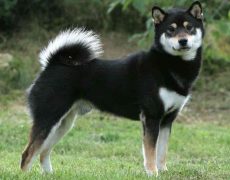Shikoku Dog
The Shikoku is a primitive Japanese breed of active, mid-sized dogs similar in appearance to the Shiba Inu. It comes with a broad forehead, long, wedge-shaped muzzle, slightly triangular, upturned eyes, firmly pricked ears, strong neck, well-developed limbs, and a high-set, thick tail curled over its back. Three distinct lines, including the Awa, Hata, and Hongawa, have been developed and named after the places they originated from on the Shikoku Island.
Shikoku Dog Pictures
- Images of Shikoku Dog
- Japanese Shikoku Dog
- Japanese Wolf Dog
- Mikawa Inu
- Shikoku Dog Images
- Shikoku Dog Photos
- Shikoku Dog Pictures
- Shikoku Dog Puppy
- Shikoku Dog
- Shikoku Dogs
- Shikoku Ken
- Shikoku Puppies
Quick Information
| Other Names | Shikoku Ken, Kochi-Ken, Japanese Wolfdog, Mikawa Inu |
| Coat | Harsh, straight outer coat, soft, dense undercoat, long hairs on the tail |
| Color | Black and tan, red, sesame with a combination of red, white, and black |
| Breed Type | Purebred |
| Category | Sporting, Asian Spitz, Northern Breed |
| Lifespan | 10-12 years |
| Weight | 35-55 lb |
| Size | Medium |
| Height | Female: 17-19 in Male: 19-22 in |
| Shedding | Moderate, seasonal |
| Temperament | Energetic, intelligent, bold, loyal, cautious |
| Hypoallergenic | Unknown |
| Good with Children | Yes |
| Barking | Rare |
| Country Originated in | Japan |
| Competitive Registration/Qualification Information | ACA, ARBS, AKC/FSS, DRA, CKC, UKC, JKC, FCI |
Video: Shikoku Dogs and Puppies
History
The Shikoku was created in the mountains of the Kochi Prefecture by the Matagi people who wanted to develop an athletic and tenacious dog that could be used for hunting boars and deer. Formerly called the Tosa Ken, these dogs were later renamed for avoiding confusion with the Tosa Inu.
After the First World War, Japan’s economy weakened. Owning a dog became uncommon, causing a decline in the population of Shikoku dogs. In 1928, an organization named Nihon Ken Hozonkai (abbreviated as NIPPO) was set up for the preservation of the native Spitz-type dogs. A significant restoration effort was undertaken after the Shikoku Ken was acknowledged as a Living Natural Monument.
Today, it is one of the rarest breeds with yearly registrations around 300-500 and total estimated population between 5,000 and 8,000 in Japan.
Temperament and Behavior
A loving family pet, the Shikoku Ken is a people friendly dog that will often greet guests with wagging tails, lots of licks or nibbles, and some jumping or lunging. Although it may alert you to anything suspicious in its territory, it will never engage the threat which makes it a poor guard dog.
As a hunting breed, it has an innate prey drive and will chase small moving objects, including birds, squirrels, and cats. Since it was bred to hunt in packs away from the owner, it is inquisitive, impulsive, and independent by nature.
It needs early socialization, or it may become dog aggressive. It can live happily with kids if raised together.
Care
Exercise
A dog of high energy and stamina, the Shikoku Ken needs a fair amount of regular exercise. Aside from taking it for long leashed walks or jogs, you may keep it both physically and mentally satiated by training it for sports like agility and obedience.
Grooming
Frequently brush its coat using an undercoat rake to remove its lose hairs, particularly during the shedding season. Bathe it only when its coat becomes dirty or has a bad odor.
Health Problems
The Kochi-Ken commonly suffers from conditions affecting its bones, joints, nerves, muscles, ears, heart, lungs, and the digestive system. Infectious diseases and trauma are also seen in some individuals.
Training
The Shikoku Ken needs firm, consistent leadership and training lest it would get stubborn.
Socialization
Give your pet Shikoku plenty of exposure to other dogs during its puppyhood. Organize play-dates and dog park romps with your friends’ or neighbors’ dogs. Also, give it lots of positive experiences with people of every size, color, and shape, including little kids, big kids, running-yelling kids, fat women, and tall men.
Leash training
Introduce your Shikoku puppy to the collar and leash and practice walking in a place with little distraction. Then, take it outside where it will encounter new sights, sounds, and smells. If your dog barks or lunges at other pets, redirect its attention using a treat before it starts going after the target.
Feeding
Give your dog a nutrient-rich, dry kibble containing 20-25 percent protein, 12-15 percent fat, moderate carbohydrate, and low levels of moisture.
Interesting Facts
- In the Japanese animated series “Ginga Legend Weed,” the four dogs that were shown assisting Jerome (Ryu, Ryo, Hanji, and Heita) are possibly Shikoku dogs.

















